Have you ever tried to upload a file to your WordPress site and hit a brick wall? It’s super frustrating when you can’t upload that image, plugin, or theme you need. Our readers often ask us for help with file upload issues because they can bring your workflow to a crawl.
Sometimes, these file upload limits can unexpectedly stop you from adding content to your media library or installing those larger plugins and themes you need. It’s like being stuck with your hands tied. And it’s even more annoying when you don’t know how to fix it!
But don’t worry, we’re here to help. We love that WordPress is such a configurable platform, and there are often multiple ways to solve the same problem.
In this guide, we’ll show you the easiest ways to increase the maximum file upload size in WordPress. We’ll get you past those limitations so you can get back to doing what you love – running your website!
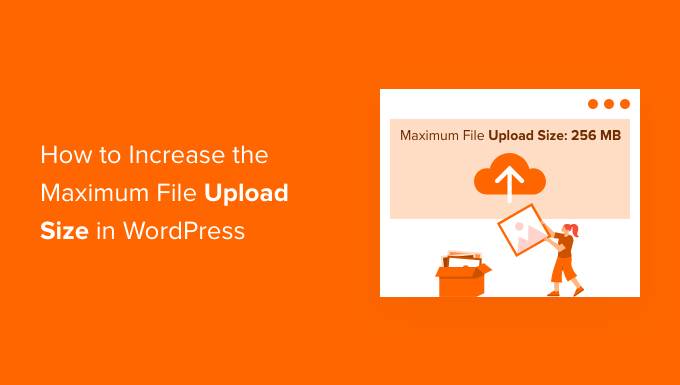
Why Increase the Maximum File Upload Size in WordPress?
Your WordPress hosting provider will set a default maximum file upload size when you sign up and install WordPress. Your hosting provider defines this limit, and it usually ranges from 2MB to 500 MB.
For most WordPress website owners, this limit will be more than enough.
However, there are times when you’ll need to raise this limit so you don’t run into upload errors.
For example:
- You run a photography website and need to upload large images.
- Your design or photography portfolio has large images.
- You want to install a larger WordPress theme or plugin.
- You want to sell digital products like eBooks, photos, videos, and more.
- You regularly update content and add audio, photos, and more that are beyond the current limit.
That being said, let’s show you how you can increase the maximum file upload size on your WordPress site.
Note: Keep in mind that displaying a lot of large files on your website can seriously slow down its speed and performance. That’s why we typically recommend never to upload videos to WordPress.
Since most users have different WordPress hosting setups, we will cover the following:
- How to Check Your Maximum File Upload Size Limit in WordPress
- Method 1: Contact Your WordPress Hosting Provider
- Method 2: Create or Edit an Existing php.ini file
- Method 3: Add Code to Your WordPress Theme functions.php File
- Method 4: Add Code to Your .htaccess File
- Method 5: Use a WordPress Plugin to Increase File Upload Size
How to Check Your Maximum File Upload Size Limit in WordPress
WordPress will automatically show the maximum file upload size limit when you are uploading images or other media.
To check this, simply go to Media » Add New in your WordPress admin panel, and you will see the maximum file upload size limit for your WordPress site.
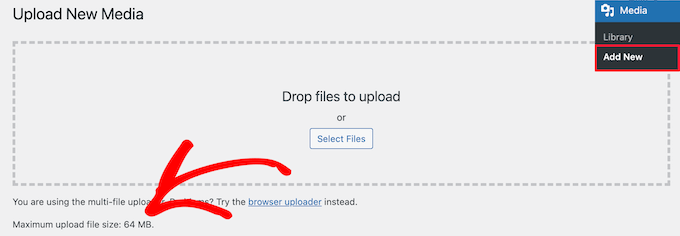
Now that you know how to find the size limit, let’s show you how to increase the maximum upload size in WordPress.
Method 1: Contact Your WordPress Hosting Provider
One of the easiest ways to increase the maximum file upload size in WordPress is to reach out to your WordPress hosting provider.
This is a relatively simple task for their customer service team and can be done in a couple of minutes.
For beginners, this can be much easier than adding code to WordPress and editing server files.
Simply head over to your hosting provider’s website, like Bluehost, and log in.
Then, click the ‘Chat’ icon at the bottom of the screen. You can then ask the support staff to increase the file upload size on your WordPress site.
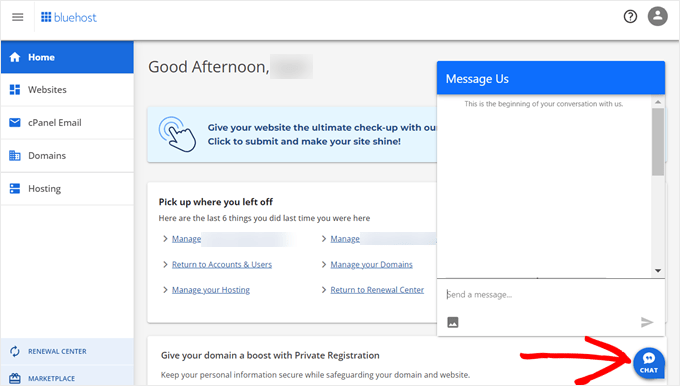
You can also reach out to support from within your hosting account dashboard.
Method 2: Create or Edit an Existing php.ini file
Another way to increase the maximum file upload size is by creating or editing a file called php.ini. This file controls a lot of settings for your WordPress hosting environment.
Most WordPress hosting providers like Bluehost have a beginner-friendly cPanel to help manage your website.
If your web host has a cPanel dashboard, then you can increase the file upload size through the built-in tools.
Note: The following is from the Bluehost cPanel. However, most shared hosting providers will have similar steps.
You will find a cPanel button at the bottom of the Hosting tab in Bluehost.
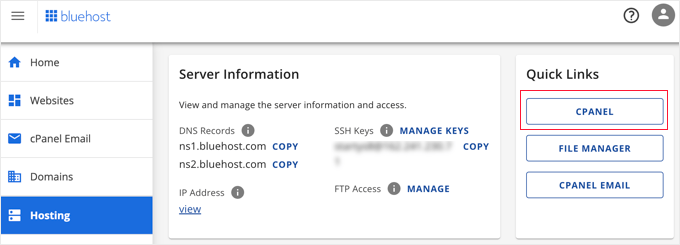
Clicking this button will open your cPanel dashboard.
Now you need to scroll down to the Software section and click on ‘MultiPHP INI Editor’.
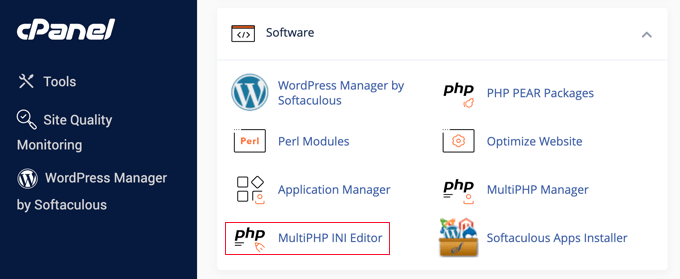
Next, scroll down to the section labeled ‘upload_max_filesize’ and enter a new maximum filesize into the box.
Then, click the ‘Apply’ button.
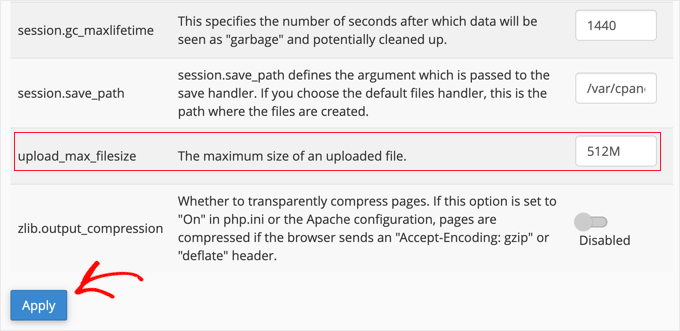
Alternatively, you can click the ‘Editor Mode’ menu tab, and then you can change the maximum file upload size directly in the editor.
You need to edit the ‘upload_max_filesize’ section to increase your file upload size.
Once you are finished, just click the ‘Save’ button.
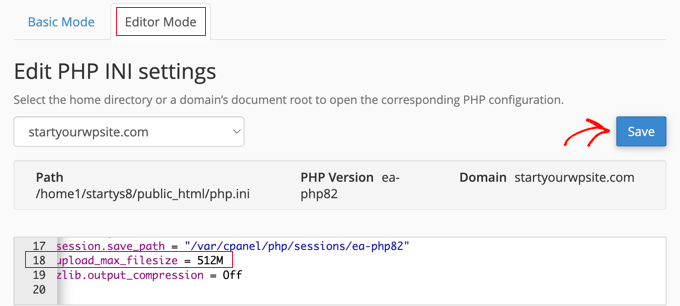
Edit php.ini by Adding Code
If your current hosting provider doesn’t offer the cPanel option, then you’ll need to edit this file manually.
To do this, you can use an FTP client or the file manager option in your WordPress hosting control panel.
If you are using shared hosting, then you might not see the php.ini file in your hosting directory. If you don’t see one, then simply create a file named php.ini and upload it to your root folder.
Then, add the following code snippet to the file:
upload_max_filesize = 256M
post_max_size = 256M
max_execution_time = 300
You can modify the ‘256M’ limit to the file size you need for your WordPress blog.
Method 3: Add Code to Your WordPress Theme functions.php File
This method involves adding code to your functions.php file in your WordPress theme.
Instead of editing the file directly, we recommend using WPCode. It’s the best code snippets plugin that allows you to add code to your website without breaking it.
If you haven’t done this before, then see our beginner’s guide on how to add custom code in WordPress.
First, you need to install the free WPCode plugin. For more details, see our step-by-step guide on how to install a WordPress plugin.
Upon activation, you should navigate to Code Snippets » + Add Snippet.
You will need to hover your mouse over the ‘Add Your Custom Code (New Snippet)’ option and then click the ‘+ Add Custom Snippet’ button.

Next, you need to choose ‘PHP Snippet’ as the code type from the list of options that appear.

On the following screen, enter a name for your new snippet, which can be anything to help you remember what the code is for.
Then, you can copy and paste the following code snippet under ‘Code Preview’. Make sure you change ‘256M’ to the maximum file size you need:
@ini_set( 'upload_max_size' , '256M' );
@ini_set( 'post_max_size', '256M');
@ini_set( 'max_execution_time', '300' );
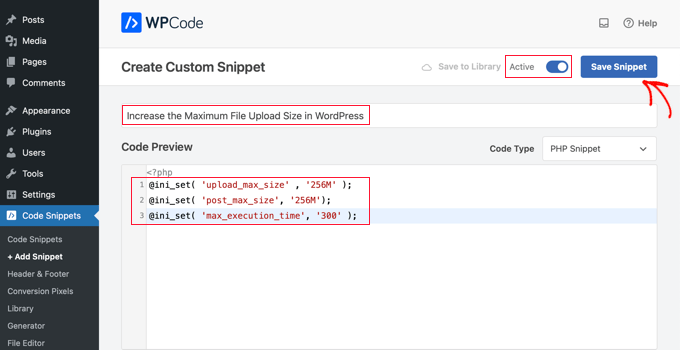
Finally, switch the toggle at the top to ‘Active’ and then click the ‘Save Snippet’ button. The code will now be executed on your website.
Method 4: Add Code to Your .htaccess File
Another way to increase the maximum file size is by modifying the .htaccess file. This file controls the high-level configuration settings for your website.
To do this, you need to log in to your website server via FTP. If you haven’t done this before, then see our guide on how to use FTP to upload files to WordPress for beginners.
After that, you need to locate your .htaccess file in your website’s root folder.

If you can’t find your .htaccess file, then it could be hidden by your file manager or FTP client. To learn more, see our guide on why you can’t find the .htaccess file on your WordPress site.
Next, you need to add the following code snippet to your .htaccess file:
php_value upload_max_filesize 256M
php_value post_max_size 256M
php_value max_execution_time 300
php_value max_input_time 300
To increase your maximum file upload size even more, simply change the ’64M’ to the size you require.
Method 5: Use a WordPress Plugin to Increase File Upload Size
Another way you can increase the maximum file upload limit is by using the WP Increase Upload Filesize plugin. If you are not comfortable adding code to WordPress, then this could be a good option for you.
The first thing you need to do is install and activate the plugin. For more details, see our guide on how to install a WordPress plugin.
Upon activation, navigate to Media » Increase Upload Limit in your WordPress admin panel.
This brings you to a screen where you can select a new file upload size in the ‘Choose Maximum Upload File Size’ drop-down.
Then, click the ‘Save Changes’ button.

Note: The maximum file upload size will be set by your hosting provider. If you need a file size limit that’s larger than the one listed in the drop-down, then you need to contact your hosting provider and ask to increase the limit.
Video Tutorial
If you don’t enjoy following written instructions, you can check out our video tutorial instead:
We hope this article helped you increase the maximum file upload size in WordPress. You may also want to see our guide on how to add additional file types to be uploaded in WordPress and our expert picks of plugins and tips to improve the WordPress admin area.
If you liked this article, then please subscribe to our YouTube Channel for WordPress video tutorials. You can also find us on Twitter and Facebook.





Abduaziz
Thanks a lot!!! Method 3 worked for me
WPBeginner Support
Glad our recommendation could help
Admin
Alexander Gartley
Thanks, this helped me troubleshoot an upload limit. I’m on a Wordpress multisite network install, so it ended up being a setting in the Network Admin Settings.
I was confused at first, because my php settings were allowing larger uploads, but it was restricted in the Network Settings.
WPBeginner Support
Thanks for sharing what solved the problem for you
Admin
Ernesto
Would have been great if you have included the .user.ini method.
.user.ini uploaded in the root folder with the same value/text in your edited php.ini
Most of the time, only this method works for shared hosting.
ErnestPH
WPBeginner Support
The php.ini file should work the same as the user.ini file unless your specific host ignores the php.ini but thank you for sharing your recommendation
Admin
Mark
This is the only solution that works on my shared hosting server. Thanks Ernesto!
Tamir Davidoff
Not working for me.
I have followed this guide and double checked the php.ini file to make sure that the changed are in fact saved. changed htaccess file to increase limits. and also tried modifying the phpMyAdmin httpd-app.conf and php-settings.conf file. All of these files reflect max upload higher than 40m and my WP site does not reflect Any of these changes. Really frustrated here.
Please help me, thanks !
WPBeginner Support
If you haven’t already, you would want to reach out to your hosting provider to ensure there is not a setting on their end that is overriding what you are setting
Admin
rajesh
i have tried all 3 method none of them worked. i am trying to upload newspaper theme in my in my wordpress site. but every time it show that php.ini file upload max file size.
plz help me
WPBeginner Support
You would want to reach out to your hosting provider to ensure they don’t have a setting that is overriding the changes you made.
Admin
Adam Walsworth
Watchout for hidden php.ini files. In my setup I found 2 of them. The one which I found actually resolved the issue was found under
./etc/php/7.0/apache2/php.ini
modifying this file fixed my issue.
WPBeginner Support
Thanks for sharing your solution, with where that file is located we would recommend most users reach out to their hosting provider before looking in locations like that.
Admin
Rafiq khan
Thanks buddy i have solved my problem by adopting method 2 by editing my php.ini file
Thanks alot you are working great
WPBeginner Support
Glad our article could help
Admin
Carla
None of the above worked for me. A matter of fact, editing the htaccess file broke my site even after deleting the above code. Overwriting with a new file fixed the problem though.
I have a dedicated server on Bluehost. What worked for me was going in the WHM root, not cpanel nor FTP access. Search for MultiPHP INI Editor. Give it at least 5 minutes to load if you only see the title and icon. You can set you upload time, post size, etc. there. Works instantly, even if your site is using Cloudflare, without placing it in development mode or clearing the cache. I hope this helps someone.
WPBeginner Support
Thank you for sharing what worked for you, should other users be on a dedicated server, if they reach out and let BlueHost know the need to increase the upload size then BlueHost can normally edit that for them
Admin
Pezza
Great Stuff! .htaccess worked for me!
WPBeginner Support
Thank you, glad our guide could help
Admin
ReineR
htaccess metod worked for me, thanks!
WPBeginner Support
Glad our article could help
Admin
Ahmed
Work for me
3. htaccess Method
you need to click (show hidden files to view and edit this file).
WPBeginner Support
Glad our article could help
Admin
rahul
when i tried this
Unable to communicate back with site to check for fatal errors, so the PHP change was reverted. You will need to upload your PHP file change by some other means, such as by using SFTP.
this happened to me
whats the solution of this
WPBeginner Support
You would need to use FTP rather than WordPress itself to add the code: https://www.wpbeginner.com/beginners-guide/how-to-use-ftp-to-upload-files-to-wordpress-for-beginners/
Admin
Ephraim
I had been trying php.ini method but it never works please how will I set it..
Or you should please tell me the were to paste at function.php
WPBeginner Support
You would normally use a text editor to set the content in the php.ini file. For your functions.php it should go at the end normally so it can be removed later as needed. You may also want to check with your hosting provider if you are having trouble with these methods for if they can assist in increasing the file size for you.
Admin
Ivos G.
None worked for me. But this one fixed it – add to your .htaccess this line:
LimitRequestBody 104857600
WPBeginner Support
Thanks for sharing your solution for this issue
Admin
Achilleas
I am using Nginx and i had already setup properly the values for php in the php.ini but what fixed it was puting the same value in the server block with the variable client_max_body_size xxxM;
I am writing this hoping it will help someone.
Editorial Staff
Thank you for sharing this with us
Admin
RAHUL
That worked for me thanx
WPBeginner Support
Glad our tutorial could help
Admin
Adriana Sabo
None of the options worked for me. Nothing happened when I tried the first two, and the last one prompted an error 500. Any way you can help?
Carl
Very helpful, thank you!
Md. Rana
The third option is worked for me.
WPBeginner Support
Hey Rana,
Glad it worked out for you. Don’t forget to follow us on Facebook for more WordPress tips and tutorials.
Admin
Tom Allen
The above explanation is fine for hosted sites, bit what about us guys that locahost? I still can figure out the “upload_max_filesize” error when downloading Updfaftplus from WP Plugins or from a download zip file. I am a beginner and need hand-holding through this process. Help is appreciated.
crystal
hta access worked.
you guys must put the code before #END Wordpress
if you put after #end wordpress then site goes to 500 internal server error in my experience with godaddy hosting
Luis Felipe Lino
Thanks.
Jaime Lopes
On most of the shared cPanel sites I’ve setup:
-changing .htaccess brings the whole site down (500 internal error)
-adding php.ini or php5.ini files does nothing
-there is no option to choose ‘Site Software’ in cPanel…
Joseph
Thanks so much. The .htaccess file worked for me
John S
Thanks so much. The .htaccess file worked for me!
Karina
Thanks you so much!!! The .htaccess version worked for me
Megan
Thank you! This was a huge help! I couldn’t even upload plugins because my limit was pre-set at 2MB…Now I’ve got it to 64MB and am able to work.
Thanks!
Okimi Solomon
Thanks a lot. The second option worked for me. God bless you
Benj
Modifying .htaccess file worked for me. Thanks a lot..
Martin Croker
On vidahost (now TSOhost).
Adding the following php.ini worked for me… however (and I’m still a bit confused why), just putting it at http root didn’t work – I had to duplicate the php.ini file inside wp-admin and wp-include directories within wordpress.
Kabelo
Very helpful. Thanks very much.
Dwayne S
I’m on HostGator and currently having issue with max execution time. It occurred a few weeks ago and HostGator support fixed the issue. It now reappeared and support is telling me that they can’t fix it because I’m on shared server. The agent even crashed my site by manually editing the htaccess file and didn’t verify if it was working or not. He did however recommend a plugin that would edit the htaccess file with code to increase the limit but it doesn’t work. I guess HostGator blocks it
Jessany
I added the code into the .php functions folder, and now Wordpress will not load. How do I fix this problem??
WPBeginner Support
Hi Jessany,
You can delete the code you added by accessing your website via FTP or File Manager in cPanel.
Admin
bala
upload the above given code to .htaccess file it is working
Caleb
I have GoDaddy hosting and contacted them to help me increase my file upload size. It was a piece of cake — I didn’t have to create any files, add code to my theme, or anything like that. So for those of you who have GoDaddy or cPanel type controls, forget hacks and just use your admin settings.
Here’s what support had me do:
1. Go to your cPanel Admin (a similar hosting panel ‘might’ work somewhat the same)
2. Scroll down to the ‘Software’ and click on ‘Select PHP Version’
3. Click on ‘Switch to PHP Options’ in the top right And TADA! There’s all your PHP Options!
4. Just go down and change the ‘post_max_filesize’ and ‘upload_max_filesize’ to whatever you want, apply and save your changes, and you’re now a safe and happy non-coding website owner.
Good luck!
ZafB
Thanks that worked perfect
Alissa
Thank you for posting this! It worked great!
Alejandra
Thanks a lot! That worked indeed!!
Paul Palmer
Brilliant solution – worked perfectly and easily! Many thanks.
Rich Perozich
This worked for me but in order to even find these files, I had to call godaddy where I was walked through these steps or I never would have been able to navigate to the cpanel Admin without their help.
1. Sign on to godaddy
2. Click on my products upper left
3. Under web hosting click manage all
4. Click web hosting with C panel
5. Click C panel Admin icon
6. Scroll down to Software and click Select php version
7. Click on switch to php options
8. At bottom of page click on the number upload_max_filesize and select # you wish as the max filesize
9. Click apply. It works. Now file sizes can be uploaded to the selected max.
Chris Sandford
Multisite Users:
If your a dumb dumb like me, you may have tried everything to no avail.
Don’t forget if you’re using Wordpress Multi-site, to change the upload settings for individual sites.
Network Admin > Settings > Max upload file size
You may still need to use the tips in this article, but without changing the upload settings for multi-site, you won’t know if it’s working.
Stef Thoen
You’re my hero. I’ve been researching this issue for way to long until I finally saw your post. Thanks so much.
Ron
Thank you for this! This should be in the body of this article!
Hitesh L.
WORKED! kudos to you!!!!!!!
Emanuel Pietri
Method 3 – with .htaccess – works fine for me with theme
Stefanos Kargas
Thanks!! I changed .htaccess file and it worked.
haadi
hi. thanks a lot. the 3rd one worked for me
Jim R
Option 2 worked good. Thanks for the info.
Tor Helge
It worked when I did the last one with .htaccess
mara
Anyone on here get this to work with Godaddy? There are very unhelpful. I know I need to create the php.ini file, (and I did), but none of the solutions you posted worked. Any help is appreciated.
WangTuanJie
after 3 method, i couldn’t see success.
Mahadi
Thanks man!! .htacces worked for me!
Lynn
Wish you wouldn’t assume everyone looking for this solution knows what you mean by our “Theme Functions File” – do you mean functions.php? I’m not an expert, and I’m really good at following precise directions, and don’t want to even put a toe in the water of editing files if I don’t know EXACTLY what file you’re talking about! No clues were provided, like what other code I might look for in the file to know I’m in the right place, etc. So…this didn’t help me at all
WPBeginner Support
Hi Lynn,
Yes you need to add it to your theme’s functions.php file.
Admin
Justin
Yea, but where does it go in the functions.php. At the top, bottom, in the middle? Inside the “”
WPBeginner Support
Hi Justin,
At the end.
jack
thank you all those steps helped me
Alex
Thank you, method 3 really worked for me
php_value upload_max_filesize 64M
php_value post_max_size 64M
php_value max_execution_time 300
php_value max_input_time 300
vikram
HI
Do you use shared hosting
shahrin
great! htaccess method work for me. I’m so relieve,guys! Thanks in advance
Samba Siva
.htaccess method worked for me
nelson
htaccess worked for me ,thank you
Sagar
php.ini is worked for me.
cheers.
thnks man !!
Mituka
This worked for me.
Open your .htacess file with notepad.
Skip everything you see and at the bottom.
Paste the following and save.
php_value upload_max_filesize 64M
php_value post_max_size 64M
php_value max_execution_time 300
php_value max_input_time 300
Thomas
Where exactly did you paste it?
# BEGIN WordPress
RewriteEngine On
RewriteBase /
RewriteRule ^index\.php$ – [L]
RewriteCond %{REQUEST_FILENAME} !-f
RewriteCond %{REQUEST_FILENAME} !-d
RewriteRule . /index.php [L]
# END WordPress
php_value upload_max_filesize 64M
php_value post_max_size 64M
php_value max_execution_time 300
php_value max_input_time 300
Is it before the #END WordPress statement? ( I get error when I do that)
Or should it be after the #END WordPress statement?
WPBeginner Support
Hi Thomas,
You need to paste it at the end of your .htaccess file after the #END WordPress line.
Admin